Let’s be honest! No one likes being sold to. Yet, for decades, businesses have relied on traditional product marketing: “Here’s our product, here’s what it does, now buy it.” But customers today? They’re tuning out that noise. They don’t care about what your product does; they care about how it fits into their lives.
That’s why the shift from product marketing to audience marketing is happening at lightning speed. Brands that fail to adapt? They risk being ignored, outperformed, and left behind.
So, what’s changing? And more importantly, how can your business make this shift successfully? Let’s break it down.
Table of Contents
What is Audience Marketing, and How is it Different from Product Marketing?
Product marketing focuses on selling a product’s features and benefits. It’s all about highlighting what makes your product great.
Audience marketing, on the other hand, flips the script. Instead of pushing a product, it’s about understanding and engaging with your audience first. It focuses on their needs, emotions, and lifestyles, then changes marketing efforts accordingly.
Here’s the key difference:
- Product marketing: “Our software has AI-powered automation.”
- Audience marketing: “Struggling to keep up with marketing tasks? Our AI handles them for you.”
See the difference? The first one talks about the product. The second one talks about the person using it. That’s the power of audience marketing.
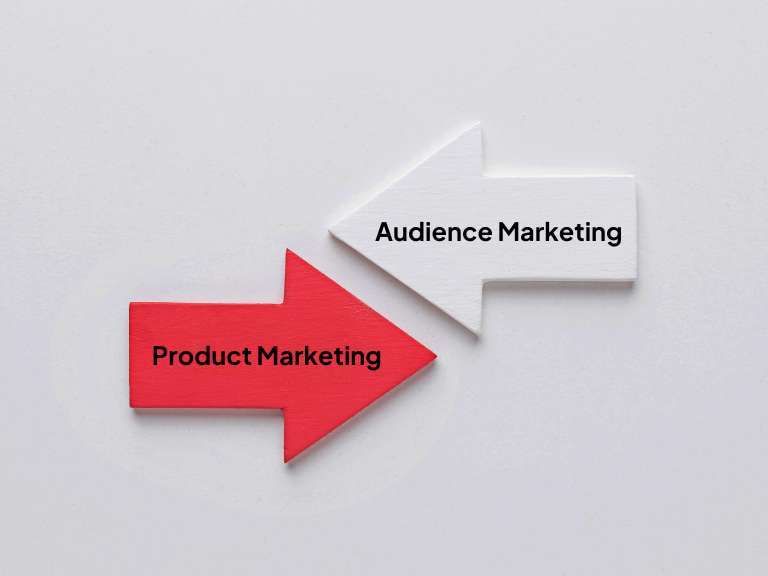
| Aspect | Product Marketing | Audience Marketing |
| Focus | Features & specifications of the product | Customer needs, emotions, & experiences |
| Messaging | “Our product has X, Y, and Z features.” | “Here’s how our product solves your problem.” |
| Targeting | Broad audience, anyone who might need it | Specific, segmented audiences based on behaviors & preferences |
| Strategy | One-size-fits-all campaigns | Personalized, data-driven marketing |
| Content Type | Product descriptions, feature lists | Storytelling, case studies, user-generated content |
| Customer Relationship | Transactional (sell the product) | Relational (build trust & long-term engagement) |
| Channels | Traditional ads, product pages | Social media, communities, personalized emails |
| Examples | “Buy our new smartphone with a 108MP camera.” | “Capture every memory in stunning detail, just like a pro photographer.” |
| End Goal | Drive sales through product appeal | Create loyal customers by addressing their needs |
Also read: Traditional marketing vs Digital marketing
Reasons Behind the Shift from Product Marketing to Audience Marketing
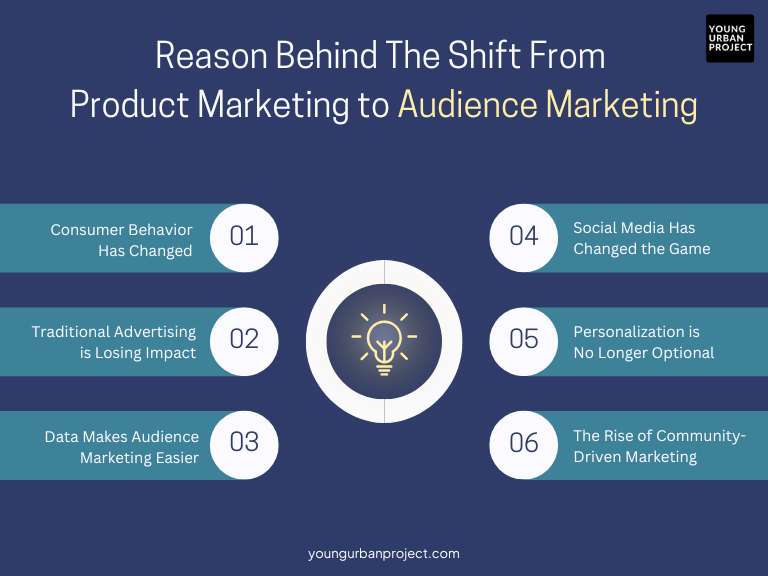
1. Consumer Behavior Has Changed
People don’t just want products; they want solutions that fit seamlessly into their lives. They research, read reviews, and seek brands that understand them.
- 81% of consumers do online research before making a purchase (Source: GE Capital Retail Bank).
- With easy access to information online, customers expect brands to provide personalized experiences that are adjusted to their needs.
2. Traditional Advertising is Losing Impact
Banner ads, TV commercials, and cold outreach? Most consumers ignore them. They engage with content that speaks directly to their interests and pain points.
- 42.7% of internet users worldwide use ad blockers (Source: Backlinko).
- Instead of interrupting consumers, successful brands focus on content marketing, storytelling, and interactive experiences to engage users.
3. Data Makes Audience Marketing Easier
With AI and analytics, brands can understand their audience’s behavior better than ever. This means more personalized, relevant marketing that actually converts.
- 91% of consumers are more likely to shop with brands that provide relevant offers and recommendations (Source: Accenture).
- Brands can now track real-time engagement, predict customer behavior, and create highly targeted marketing campaigns that drive conversions.
4. Social Media Has Changed the Game
People interact with brands more than ever on social media. They expect brands to engage, respond, and provide value—not just advertise.
- 54% of social media users research products on social platforms before making a purchase (Source: GlobalWebIndex).
- Brands that use social listening and engage meaningfully see higher customer loyalty and trust.
Also read: Scope of Social Media Marketing: Career Opportunities and Future
5. Personalization is No Longer Optional
Consumers expect brands to know them and cater to their needs. Generic marketing messages won’t cut it anymore.
- 80% of shoppers are more likely to buy from a company that offers personalized experiences (Source: Epsilon).
- Whether through AI-driven recommendations, targeted emails, or customized offers, personalization is now a must-have marketing strategy.
6. The Rise of Community-Driven Marketing
People trust other people more than brands. Communities, influencer marketing, and word-of-mouth recommendations have become powerful marketing tools.
- 92% of consumers trust peer recommendations over traditional ads (Source: Nielsen).
- Companies that build strong online communities foster brand loyalty, drive engagement, and create more meaningful customer relationships.
How to Shift to Audience Marketing
Making the transition isn’t as hard as it sounds. Here’s how you can do it step by step.
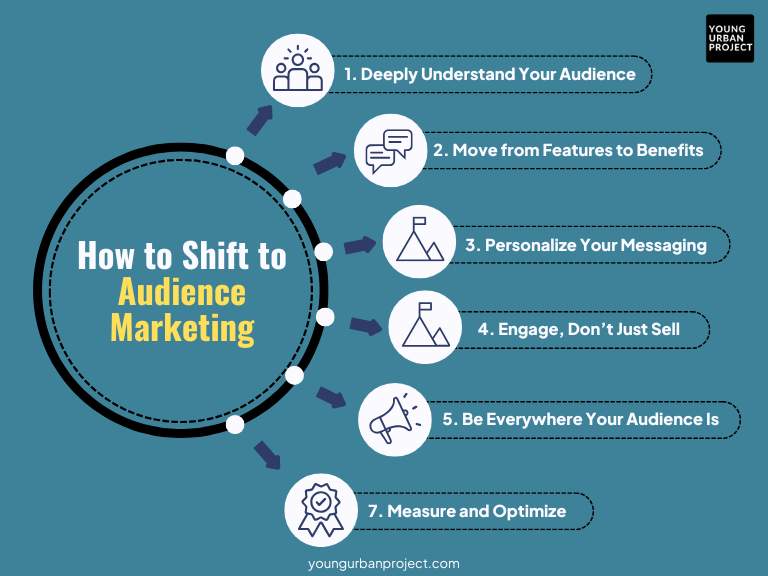
1. Deeply Understand Your Audience
Stop guessing who your customers are. Start knowing them. Use:
- Surveys and interviews to get direct insights into their pain points and desires.
- Social media insights to see what content resonates with them.
- Website analytics to track behavior and engagement patterns.
- Customer feedback to refine messaging and offerings.
Create detailed audience personas with demographics, behaviors, needs, and preferred communication channels. The more detailed, the better your marketing will be.
2. Move from Features to Benefits
People don’t buy products—they buy solutions. Instead of listing features, answer: “How does this help my audience?”
For example:
- Product-focused: “Our mattress is made of memory foam.”
- Audience-focused: “Wake up pain-free with a mattress that supports your back.”
Make sure every marketing message clearly shows how your product improves their lives.
3. Personalize Your Messaging
Generic marketing doesn’t work anymore. Customers expect tailored experiences. Use personalization tactics like:
- Email segmentation: Send the right message to the right person based on their behavior and interests.
- Dynamic content: Adjust website content based on visitor behavior and past interactions.
- Retargeting ads: Remind potential customers of the products they showed interest in.
- AI-powered recommendations: Use machine learning to suggest products based on previous purchases or browsing history.
Also read: Positioning vs Messaging: Key Differences Explained
4. Leverage Storytelling
Stories create emotional connections. Instead of stating product specs, tell a story:
- Instead of: “Our shoes have the best cushioning.”
- Say: “Meet Sarah, a runner who struggled with knee pain—until she found these shoes. Now, she runs pain-free every day.”
Use real customer experiences, case studies, or brand narratives to make your messaging compelling.
5. Engage, Don’t Just Sell
Your audience doesn’t want a sales pitch—they want valuable content. Share:
- Educational blogs: Teach them something useful.
- Entertaining videos: Keep them engaged.
- Interactive quizzes: Help them discover what they need.
- Customer success stories: Show how others benefited from your product.
Building trust leads to higher conversions.
6. Be Everywhere Your Audience Is
Don’t expect customers to come to you. Go where they are:
- If they hang out on Instagram, create engaging reels and carousel posts.
- If they prefer LinkedIn, post thought-leadership content and engage in discussions.
- If they love YouTube, invest in high-quality video content.
- If they use forums like Reddit, contribute meaningful insights.
Omnichannel marketing ensures your message reaches them where they’re most comfortable.
7. Measure and Optimize
Audience marketing isn’t a one-time thing. Track what’s working and improve continuously. Measure:
- Engagement rates: How much your audience interacts with your content.
- Click-through rates: The percentage of people who take action.
- Conversion rates: How many leads turn into paying customers.
- Customer retention: How well you’re keeping customers engaged long-term.
Use A/B testing to refine campaigns and ensure maximum impact. The more you optimize, the better your audience connection and marketing results will be.
Also read: What Is Digital Marketing ROI: How to Measure It, Key Metrics and Calculation Methods
Audience marketing examples
1. Starbucks – AI-Powered Audience Targeting
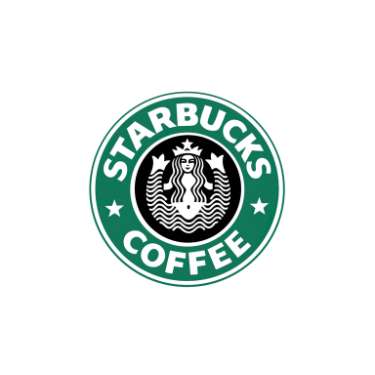
- Audience Segment: Coffee lovers, commuters, professionals, students
- Example: Starbucks uses AI in its app to personalize promotions based on purchase history. If you buy a caramel macchiato often, you’ll get discounts or special offers for that drink.
- Personalization: Starbucks’ loyalty program offers custom rewards based on user behavior.
2. Cred – Exclusive Community Marketing
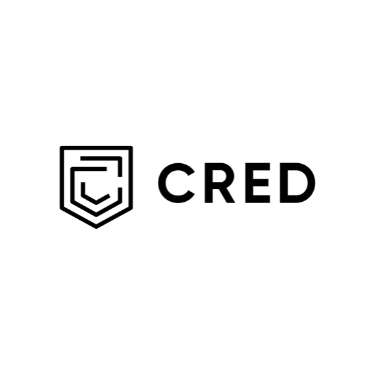
- Audience Segment: High-income, credit-savvy users (people with high credit scores)
- Example: Instead of targeting everyone, Cred positions itself as a premium brand for financially responsible users. Their ads use humor and celebrity endorsements to appeal to urban millennials.
- Personalization:
- Exclusive rewards for premium users
- In-app gamification to encourage bill payments
3. Airbnb – Personalized Travel Experiences
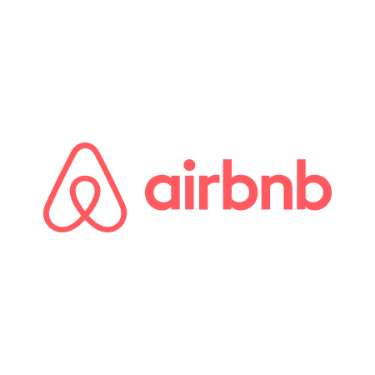
- Audience Segment: Travelers, solo backpackers, families, luxury vacationers
- Example: Airbnb segments its users and recommends travel experiences based on browsing history and past bookings.
- Personalization: They show different types of listings depending on whether you’re a budget traveler, luxury traveler, or business traveler.
4. Sephora – Beauty Insider Program

- Audience Segment: Makeup and skincare lovers, beauty influencers
- Example: Sephora’s loyalty program, Beauty Insider, segments customers into tiers (Insider, VIB, Rouge), offering personalized recommendations and exclusive rewards.
- Personalization: Their app tracks past purchases and recommends products tailored to each customer’s skin type, shade, and preferences.
5. Zomato – Hyperlocal & Humor-Based Marketing

- Audience Segment: Young urban professionals, foodies, online food delivery users
- Example: Zomato tailors its marketing based on local audience preferences. They use relatable, witty, and pop-culture-driven content to engage young users on social media.
- Personalization:
- Push notifications that match user behavior (e.g., “Late night? Order from your favorite place!”)
- City-based offers and restaurant recommendations
Also read: The Difference Between Selling and Marketing
🚀The Future: Why Audience Marketing is Here to Stay
The world isn’t going back to product-first marketing. The brands that understand their audience, speak their language and offer value beyond a product are the ones that win.
If you want your brand to stay relevant, you might want to try audience marketing. So, start focusing on people, not just products. That’s how you build customer relationships and a brand that actually matters.
Now, let’s go over to you. How are you planning to make the shift?
FAQs
1. What’s the main difference between product marketing and audience marketing?
Product marketing is about telling people what your product can do. On the other hand, audience marketing is about showing them how it fits into their lives. So, don’t say “Our software has AI-powered automation.” Say, “Save hours every week with AI that does the boring tasks for you.” It’s about shifting the focus from what you sell to how it benefits your audience.
2. Can small businesses actually make audience marketing work?
Absolutely! You don’t need a huge budget to connect with your audience. Even small businesses can: 1. Use social media to interact with customers in real-time 2. Create content that answers real customer questions 3. Build email lists and send personalized messages 4. Listen to customer feedback and adjust marketing accordingly
3. How does audience marketing help keep customers loyal?
Simple: when people feel seen and understood, they stick around. If your brand speaks their language, solves their problems, and keeps them engaged with valuable content, they’ll keep coming back. That’s why brands like Apple and Nike don’t just sell products—they sell lifestyles.
4. What tools can help me shift to audience marketing?
If you’re serious about making the switch, here are a few must-haves:
1. HubSpot or Salesforce – for understanding your audience and tracking customer interactions
2. Klaviyo or Mailchimp – for sending highly targeted emails
3. Google Analytics or Hotjar – for seeing what content actually resonates
4. Sprout Social or Brandwatch – for listening to what your audience is saying online.
5. How do I know if audience marketing is working?
Look at the numbers that actually matter:
1. Engagement rates – Are people interacting with your content?
2. Customer lifetime value (CLV) – Are they sticking around and buying more?
3. Conversion rates – Are your efforts turning into actual sales?
4. Retention rates – Are customers coming back, or are they one-and-done?

